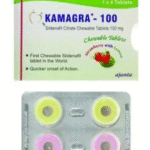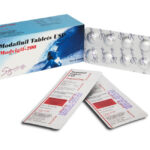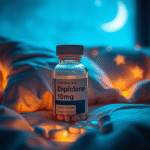Understanding Narcolepsy and Modafinil
Thank you for reading this post, don't forget to subscribe!What is Narcolepsy? Narcolepsy is a chronic neurological disorder that affects the brain’s ability to regulate sleep-wake cycles normally. People with narcolepsy experience:
- Excessive daytime sleepiness (EDS)
- Sudden sleep attacks during daily activities
- Disrupted nighttime sleep
- Sometimes cataplexy (sudden muscle weakness triggered by emotions)
The Core Problem: The brain cannot properly maintain wakefulness during the day or consolidated sleep at night, leading to intrusive sleep episodes and chronic fatigue.
How Modafinil Works for Narcolepsy
Mechanism of Action
1. Dopamine System Enhancement
- Modafinil uk blocks dopamine reuptake transporters
- Increases available dopamine in brain regions responsible for wakefulness
- Particularly targets the nucleus accumbens and prefrontal cortex
- Enhances motivation, alertness, and cognitive function
2. Histamine System Activation
- Stimulates histamine release in the brain
- Histamine is a key neurotransmitter for maintaining wakefulness
- Helps sustain alertness throughout the day
- Reduces the tendency to fall asleep involuntarily
3. Orexin/Hypocretin System Support
- While narcolepsy often involves orexin deficiency, modafinil may help compensate
- Supports downstream pathways that orexin normally activates
- Helps maintain arousal and prevent sleep attacks
4. Norepinephrine Enhancement
- Increases norepinephrine activity
- Promotes alertness and attention
- Helps maintain cognitive performance during the day
Specific Benefits for Narcolepsy Patients
Primary Symptom Management
1. Excessive Daytime Sleepiness (EDS)
- Reduction in Sleep Attacks: Significantly decreases sudden, uncontrollable sleep episodes
- Sustained Wakefulness: Helps patients stay awake during normal daytime hours
- Improved Alertness: Enhances overall alertness levels throughout the day
- Better Quality of Wakefulness: Not just staying awake, but feeling more alert and functional
2. Cognitive Function Improvement
- Enhanced Concentration: Better ability to focus on tasks
- Improved Memory: Both working memory and long-term memory function
- Executive Function: Better decision-making and problem-solving abilities
- Processing Speed: Faster mental processing and reaction times
3. Functional Capacity Enhancement
- Work Performance: Ability to maintain productivity during work hours
- Social Functioning: Reduced embarrassment from falling asleep in social situations
- Driving Safety: Decreased risk of falling asleep while driving
- Academic Performance: Better classroom attention and learning capacity
Quality of Life Improvements
1. Independence and Safety
- Reduced risk of accidents due to sudden sleep episodes
- Greater confidence in daily activities
- Ability to drive safely (with medical clearance)
- Reduced need for constant supervision
2. Professional and Educational Benefits
- Ability to maintain regular work schedules
- Improved job performance and career prospects
- Better academic achievement
- Reduced absenteeism
3. Social and Emotional Well-being
- Reduced social isolation
- Improved relationships
- Better self-esteem and confidence
- Decreased depression and anxiety related to the condition
Clinical Effectiveness
Research Findings
Efficacy Studies:
- 70-80% of patients experience significant improvement in daytime sleepiness
- Sleep latency improvement: Patients can stay awake 2-4 hours longer before falling asleep
- Maintenance of Wakefulness Test (MWT): Significant improvements in ability to stay awake in boring situations
- Epworth Sleepiness Scale: Substantial reductions in subjective sleepiness ratings
Functional Improvements:
- Work productivity: Studies show 40-60% improvement in work-related functioning
- Driving simulator performance: Significant improvements in driving safety measures
- Quality of life scores: Marked improvements across multiple life domains
Onset and Duration
Time to Effect:
- Initial response: Often within 1-2 hours of first dose
- Full therapeutic effect: Usually achieved within 1-2 weeks
- Peak plasma levels: Reached 2-4 hours after oral administration
Duration of Action:
- Half-life: 12-15 hours in most patients
- Effective duration: Typically 8-12 hours of improved wakefulness
- Once-daily dosing: Usually sufficient for most patients
Dosing and Administration
Standard Dosing
Initial Dose:
- Starting dose: Usually 200mg once daily in the morning
- Timing: Taken in the morning to avoid nighttime sleep interference
- With or without food: Can be taken either way
Dose Adjustments:
- Range: 100-400mg daily (200mg most common)
- Titration: Adjusted based on response and side effects
- Individual variation: Some patients need higher or lower doses
Dosing Considerations
Special Populations:
- Elderly patients: Often start with lower doses (100mg)
- Liver impairment: Dose reduction may be necessary
- Kidney disease: Usually no adjustment needed
Timing Strategies:
- Single morning dose: Most common approach
- Split dosing: Sometimes 200mg morning + 100mg early afternoon
- Shift work: Timing adjusted for work schedule
Side Effects and Management
Common Side Effects of Modafinil
Mild to Moderate:
- Headache (most common, 30-40% of patients)
- Nausea (10-15% of patients)
- Nervousness or anxiety (5-10% of patients)
- Dizziness (5% of patients)
- Insomnia (if taken too late in day)
Management Strategies:
- Most side effects are dose-dependent and may improve with time
- Taking with food may reduce nausea
- Staying hydrated can help with headaches
- Proper timing prevents sleep interference
Rare but Serious Side Effects of Modafinil tablets
Severe Skin Reactions:
- Stevens-Johnson syndrome (very rare)
- Toxic epidermal necrolysis (extremely rare)
- Requires immediate medical attention
Psychiatric Effects:
- Mood changes or depression (rare)
- Anxiety or agitation (uncommon)
- Hallucinations (very rare)
Advantages Over Other Treatments
Compared to Traditional Stimulants
1. Lower Abuse Potential:
- Modafinil uk has much lower addiction risk than amphetamines
- Less euphoric effect
- Fewer withdrawal symptoms when discontinued
2. Better Side Effect Profile:
- Less anxiety and jitteriness
- Fewer cardiovascular effects
- Less appetite suppression
- Better sleep architecture preservation
3. Smoother Effect:
- Less “up and down” feeling throughout the day
- More sustained wakefulness
- Fewer rebound effects
Functional Advantages
1. Cognitive Enhancement:
- Not just wakefulness, but improved cognitive function
- Better executive function than simple stimulants
- Enhanced decision-making abilities
2. Mood Stability:
- Less likely to cause mood swings
- May have mild antidepressant effects
- Better emotional regulation
Long-term Use and Monitoring
Chronic Treatment
Long-term Effectiveness:
- Maintains efficacy over years of use
- Low risk of tolerance development
- Consistent improvement in quality of life measures
Monitoring Requirements:
- Regular follow-up: Every 3-6 months initially
- Blood pressure monitoring: Periodic checks
- Heart rate assessment: Regular monitoring
- Liver function: Occasional testing if indicated
- Sleep study updates: Periodic reassessment
Treatment Optimization
Combination Approaches:
- Sometimes combined with other narcolepsy medications
- May be used with sodium oxybate for comprehensive treatment
- Sleep hygiene education remains important
Lifestyle Integration:
- Strategic napping may still be beneficial
- Regular sleep schedule maintenance
- Stress management techniques
- Exercise and dietary considerations
Patient Success Stories and Outcomes
Typical Patient Experience
Before Modafinil:
- Falling asleep 10-20 times per day
- Unable to drive safely
- Difficulty maintaining employment
- Social isolation and depression
After Modafinil Treatment:
- 1-3 sleep episodes per day (if any)
- Able to drive with medical clearance
- Successful career maintenance
- Improved relationships and social life
Quality of Life Measures
Functional Improvements:
- Work attendance: 80-90% improvement
- Social participation: Significant increases
- Independence: Marked improvement in daily living activities
- Safety: Dramatic reduction in accident risk
Important Considerations
Medical Supervision
Essential Medical Management:
- Proper diagnosis confirmation before starting
- Regular monitoring during treatment
- Adjustment based on response and side effects
- Coordination with other treatments
Patient Education:
- Understanding of proper timing and dosing
- Recognition of side effects
- Importance of medication compliance
- Sleep hygiene maintenance
Limitations
What Modafinil Doesn’t Do:
- Doesn’t cure narcolepsy
- May not eliminate all symptoms
- Doesn’t prevent cataplexy (in Type 1 narcolepsy)
- Requires ongoing treatment
Conclusion
Modafinil represents a major advancement in narcolepsy treatment, offering patients the opportunity to regain much of their normal wakefulness and functionality. By targeting multiple neurotransmitter systems involved in sleep-wake regulation, it provides sustained alertness with relatively few side effects.
The medication has transformed the lives of many narcolepsy patients, allowing them to:
- Return to work or school
- Drive safely
- Participate in social activities
- Maintain relationships
- Achieve greater independence
While not a cure, modafinil offers excellent symptom management that can dramatically improve quality of life for people with narcolepsy when used under proper medical supervision. The key to success is working closely with healthcare providers to optimize dosing, monitor for side effects, and integrate the medication into a comprehensive treatment plan that may include other medications, lifestyle modifications, and ongoing medical care.








